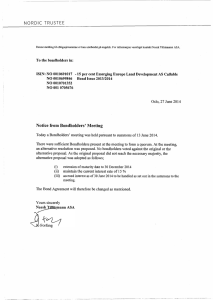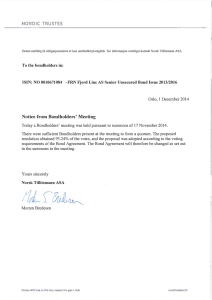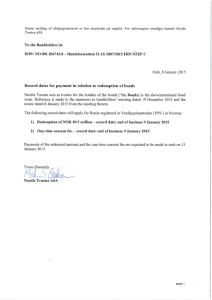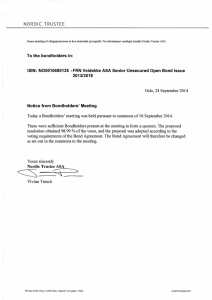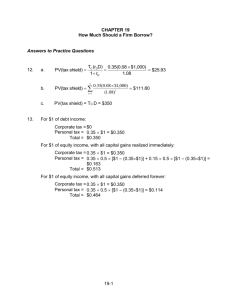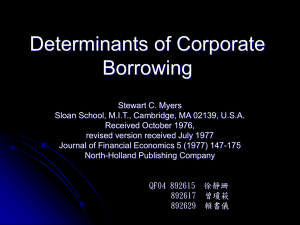The effects of mergers on the value of debt.
advertisement
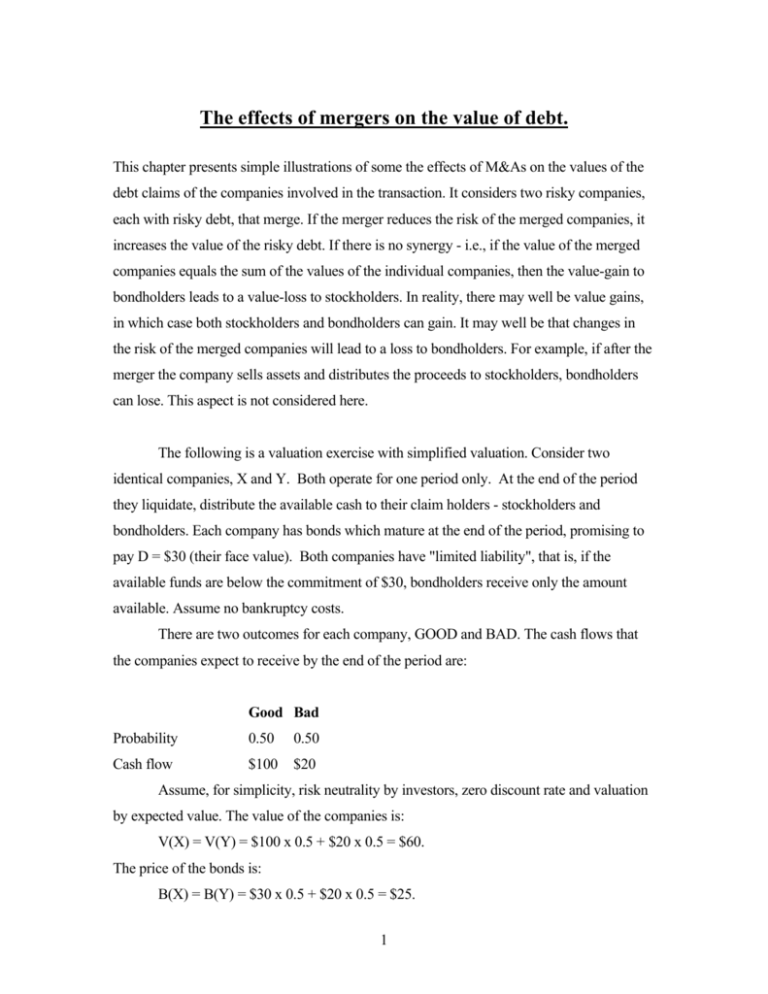
The effects of mergers on the value of debt. This chapter presents simple illustrations of some the effects of M&As on the values of the debt claims of the companies involved in the transaction. It considers two risky companies, each with risky debt, that merge. If the merger reduces the risk of the merged companies, it increases the value of the risky debt. If there is no synergy - i.e., if the value of the merged companies equals the sum of the values of the individual companies, then the value-gain to bondholders leads to a value-loss to stockholders. In reality, there may well be value gains, in which case both stockholders and bondholders can gain. It may well be that changes in the risk of the merged companies will lead to a loss to bondholders. For example, if after the merger the company sells assets and distributes the proceeds to stockholders, bondholders can lose. This aspect is not considered here. The following is a valuation exercise with simplified valuation. Consider two identical companies, X and Y. Both operate for one period only. At the end of the period they liquidate, distribute the available cash to their claim holders - stockholders and bondholders. Each company has bonds which mature at the end of the period, promising to pay D = $30 (their face value). Both companies have "limited liability", that is, if the available funds are below the commitment of $30, bondholders receive only the amount available. Assume no bankruptcy costs. There are two outcomes for each company, GOOD and BAD. The cash flows that the companies expect to receive by the end of the period are: Good Bad Probability 0.50 0.50 Cash flow $100 $20 Assume, for simplicity, risk neutrality by investors, zero discount rate and valuation by expected value. The value of the companies is: V(X) = V(Y) = $100 x 0.5 + $20 x 0.5 = $60. The price of the bonds is: B(X) = B(Y) = $30 x 0.5 + $20 x 0.5 = $25. 1 (Note that the "promised yield" on the bonds is 30/25 -1 = 20%, whereas the expected yield is 0%) The value of the stock is: S(X) = S(Y) = ($100 - $30) x 0.5 + 0 x 0.5 = $35. The value of the stocks is the residual value after having paid out the bonds. Therefore, S = V - B = 60 - 25 = 35. Before proceeding, note the value-returns for the two states, Good and Bad, are 66.7% (=100/60 – 1) or -66.7% (= 20/60 – 1). The expected return is 0%, by construction. The return variance is: Var(Rx) = Var(Ry) = (0.667)2 x 0.5 + (-0.667)2 x 0.5 = 0.444. Now, assume that companies X and Y merge into one company, Z, with no synergy. That is, no additional value is created in the merger. We also assume that the outcomes for each company are independent of the outcomes of the other, and thus the cash flows are independent. The following matrix represents the cash flows and their probabilities for the merged company, Z. Y: Good Y: Bad X: Good $200 (0.25) $120 (0.25) X: Bad $120 (0.25) $ 40 (0.25) The numbers in the parentheses are the joint probabilities of realizing the cash flows, which are the sum of the companies' cash flows under the respective states. The value of company Z is: V(Z) = 200 x 0.25 + 120 x 2 x 0.25 + 40 x 0.25 = 120. or V(Z) = V(X) + V(Y) = 60 + 60 = 120. Company Z also holds now the debt of both companies X and Y. Thus, the redemption value of the debt of Z is $60 (= 30 + 30). The market value of this debt is as follows: B(Z) = $60 x 0.75 + $40 x 0.25 = $55 ( > 50 = 25 + 25). 2 Now, the full value of the debt, $60, can be paid with probability 0.75. Only when both companies have bad results, with probability of 0.25, there will be $40 available for bondholders. Before, the full value of debt was paid with probability of 0.5 for each firm. Note that the company became now less risky. If you calculate the returns that correspond to the cash flows of firm Z you obtain that the return variance is as follows: Var(Rz) = 0.6672x0.25 + 0x2x0.25 + (-0.667)2x0.25 = .222 or, using the portfolio approach and noting that X and Y are of equal size, Var(Rz) = 0.444x(0.5)2x2 = 0.222. That is, the risk of firm Z's return is lower than that of X or Y. This result should be expected from portfolio theory - the independence of the two firms' returns leads to diversification and risk-reduction. Bondholders are the beneficiaries from the risk reduction. Wealth Transfer The value of the bonds increases from $50 (= 25 + 25) to $55. This increase in value comes at the expense of the stockholders: The value of their stock declines. S(Z) = (200 - 60) x0.25 + (120 - 60) x2 x0.25 + 0 x0.25 =65. or S(Z) = V(Z) – B(Z) = 120 – 55 = 65 ( < 70 = 35 + 35). Stockholders thus loose $5 which are transferred to bondholders. The wealth transfer occurs because of the "weakening" of the limited liability of stockholders. Before, in bad states stockholders were not liable for the inability to redeem the bonds in full. Now, if one company is in the bad state and the other is in the good state, the stockholders of the "good" company are liable for the debt of the "bad" one. That is, stockholders have now extended their liability. Only if both companies are in a bad state will the limited liability be as in the initial situation, when the two companies were separate. Also, note that the risk faced by bondholders is lower in the merged company, and this benefits them and hurts stockholders. By the theory of finance, the company's equity can be viewed as a call option on the value of the firm with the exercise (strike) price being the redemption value of debt. From options theory we know that if the volatility of the underlying asset decreases, the value of the option decreases. Here, because the volatility of the combined company decreases after the merger, the value of the equity decreases. Given that the total value of the companies remains unchanged, the value of the debt increases. 3 What can stockholders do to restore the value of their stock? Assume that the company can issue additional debt at the same terms as the existing debt (pari pasu with the old debt). Then, assume the company issues additional debt with face value of $60, with the proceeds being paid out to stockholders. Because the proceeds do not remain in the company (the investments are unchanged), the cash flows of the company are as before. The total debt liability is now $120 (= 60 + 60) and its total value, denoted by B1, is: B1(Z) = 120 x 3 x 0.25 + 40 x 0.25 = 100. Now, the new and old bondholders share the new value of the bonds. Each group has claims with face value of $60 and receives $50 in value, exactly as before. The value of the stock now is S(Z) = (200 - 120) x 0.25 + 0 x 3 x 0.25 = 20 or S(Z) = V(Z) - B1(Z) = 120 – 100 = 20. The stockholders' wealth is now 70: they have 20 in market value and 50 in cash obtained from the proceeds of selling the new bond issue. The debt/value ratio of Z is now 100/120, whereas before it was, for each company, 25/60. There is a considerable increase in leverage, yet the "promised yield" is the same as before, 20% (= 120/100 - 1; the expected yield is still 0%, by construction). That is, the merger increased the "debt capacity" of the companies. [Think: what if company Z issues new bonds with face value of 70 (instead of 60), pari pasu with the old bonds? Who gains, who loses and how much?] If the company cannot issue new bonds with the same priority rights as the old bonds (say, because of restricting bond covenants), the value transfer cannot be changed. If the company issues additional debt with face value of $60 which has a lower priority than (subordinated to) the old debt, the new bondholders will receive their value after the senior bondholders have received theirs. The market value of the new debt, denoted Bn(Z), is: Bn(Z) = (120 - 60) x 0.25 x 3 + 0 x 0.25 = 45. The total value of the debt is still 100 (= 55 + 45). The stock value is 20, but the wealth of the stockholders is only 65, not 70, because they received only 45 for the new debt. The promised yield on the new debt is higher than that on the old debt: it is 33% (= 60/45 - 1). 4 This should be expected: Bonds with lower priority have higher promised yield. The expected yield is still 0%. From the senior bondholders' viewpoint, it does not matter who is behind them in line, shareholders or subordinated bondholders. Their wealth is the same in both cases. This would not be the case if there were bankruptcy costs or deviations from strict priority. Then, the raising of additional subordinated debt may worsen the situation for the senior bondholders. Not all mergers generate wealth-transfer from stockholders to bondholders. Consider now a case where X and Y merge, but assume that their cash flows are perfectly positively correlated. That is, the two companies are identical, and whatever happens to one happens to the other. Then, the cash flow matrix of Z is as follows: Y: Good Y: Bad X: Good 200 (0.50) * X: Bad * 40 (0.50) The events marked by * never occur, since it is impossible that there are different situations in the two companies. Then, V(Z) = 120, B(Z) = 50, S(Z) = 70. Here, there is no wealth transfer in the merger. But raising of any additional debt (at the same terms as the existing debt) will lead to value loss to the senior bondholders and a wealth transfer to shareholders. Risk effect Next, consider a wealth transfer between different classes of bondholders of the merging companies; one class can gain and the other can lose. Consider two companies with different risks: Good Bad Probability 0.50 0.50 X: Cash flow $100 $20 Y: Cash flow $36 $0 The values of these companies are: V(X) = 60 (as before); V(Y) = 36 x 0.50 + 0 x 0.50 = 18. 5 Assume again that both companies have outstanding debt with face value of $30. The bonds' market values are B(X) = 25 (as before); B(Y) = 30 x 0.5 + 0 x 0.5 = 15. The bonds of X have a promised yield of 20%, as before, and the bonds of Y have a promised yield of 100% (= 30/15 – 1). Y's bonds are riskier: in X, bondholders receive 30 or 20, whereas in Y, bondholders receive 30 or 0. The stock values are: S(X) = 35; S(Y) = 3 (= 18 – 15). Assume again that the two companies' cash flows are independent. The cash-flow matrix after they merge is: Y: Good Y: Bad X: Good $136 (0.25) $100 (0.25) X: Bad $ 56 (0.25) $ 20 (0.25) The face value of the bonds of the joint company is now 60. The bond value is B(Z) = 60 x 2 x 0.25 + 56 x 0.25 + 20 x 0.25 = 49, and the stock value is S(Z) = V(X) + V(Y) – B(Z) = 60 + 18 - 49 = 29. We have here two wealth transfers. First, there is again a wealth transfer from stockholders to bondholders: before, bond value was 40 (=25 + 15) and after the merger it is 49. In addition there is wealth transfer between the two bond issues. Recall that both have the same face value. If the terms of the merger are that both bond issues have equal priority, then given their equal face value, the bond value will be equally split between the two (old) groups of bondholders. The market value of each old bond issue will now be 24.5 (= 1/2 x 49). This represents a loss of 0.5 in value to the bondholders of X and a gain of 9.5 to the bondholders of Y (the riskier company). In summary, this merger brought wealth transfers 1) from stockholders to bondholders (stockholders lose 9); and 2) from the higher-quality (less risky) to the lower-quality (riskier) bonds: the higherquality bonds lose 0.5 to the lower-quality bonds. 6 Maturity effect Consider now a different scenario: Company X operates for two periods whereas company Y operates for one period only. Both have debt with face value of 30; the debt of company X matures at the end of period II and the debt of company Y matures at the end of period I. The cash flows of both companies are as before. Those of company X are obtained at the end of the second period and there is no realization of cash flows at the end of the first period. Because of the zero discount rate, the values of both companies, as well as the values of the stocks and bonds, are the same as before: V(X) = V(Y) = 60 B(X) = B(Y) = 25 S(X) = S(Y) = 35. Assume again that the cash flows of both companies are independent. Now, suppose both companies merge and form company Z. Assume that because the stock values of both companies are equal, they share equally in the merged company. The cash flows of Z are then as follows: Period I: 100 or 20 with probability 0.5 each. Period II: 100 or 20 with probability 0.5 each. If the cash flow in period I is 100, Z can redeem the debt of 30 and distribute the remaining 70 to shareholders. But if the cash flow in period I is 20, Z can either default -- in which case the value of the stock is 0 -- or borrow additional funds against its expected period-II income. Clearly, stockholders prefer the second alternative (why?). Then, Z borrows 10 and together with the available 20 it can redeem the bonds of old Y. What is the face value of the debt issued by Z? Z needs to raise 10, so the face value is clearly higher, and it depends on the priority of the new debt relative to the old (of X). Suppose first that the new debt has lower priority (it is subordinated to the old debt). Then, because its value has to be 10 (= the amount to be raised) its face value, F, is obtained from the following: F x 0.5 + 0 x 0.5 = 10; ==> F = 20. (Recall that if cash flow in period II is 20, there is nothing left for the new debt). Z thus has old debt with face value of 30 and a new debt with face value of 20. The value of the debt in the last (beginning of second) period is 7 B(Z) = 25 + 10 = 35. The value of the company at the beginning of period II is still 60, and therefore the value of the stock then is S(Z) = V(Z) - B(Z) = 60 - 35 = 25. Note that this situation - borrowing additional amount to repay the first-period debt is preferable to declaring bankruptcy at the end of the first period, in which case stockholders receive zero, assuming the company ceases to exist then. If stockholders terminate the operation of the company, they forego the option value available to them. It is as if you had a two-period call option which you decide to exercise at the end of the first period. What is the value of the stock as of the beginning of period I? There is 0.5 probability that the cash flow of Y will be 100. Then, stockholders receive 70 and hold stock with a market value of 35. Alternatively, if the realized cash by the end of the first period is 20, stockholders receive nothing then and hold stock whose market value is 25. The stock value is then: S(Z) = (70 + 35) x 0.5 + 25 x 0.5 = 65. Recall that the initial market value of the stocks of the two companies was 70 (= 35 + 35). The wealth-transfer here is as follows: • Bondholders of X have no change in the value of their bonds. • Bondholders of Y gain 5: Before, B(Y) = 25, whereas after the merger, they surely have their bonds redeemed for 30. • Stockholders lose 5. Put differently, there's a probability of 0.5 that the stockholders will pay 10 in the first period to buy the option to keep on going for another period. The result is that the short-term bonds gain at the expense of shareholders. This is because the risky bonds of Y become riskless - shareholders will always prefer to redeem them rather than go bankrupt at the end of the first period. Now assume that the new bonds issued at the end of period I (in case that the cash flow then is only 20) are pari pasu with the existing bonds. Then, the face value of the new bonds, F, is calculated as follows: (assume that in the case of default, the available cash is divided in proportion to the face value of the bonds): F x 0.5 + 20 x F/(F + 30) x 0.5 = 10; F = 13.72. 8 The total value of the debt of Z as of the beginning of period II is B(Z) = (30 + 13.72) x 0.5 + 20 x 0.5 = 31.86, and the value of the old debt is then 21.86 (=31.86x30/(30+13.72)). The value of the stock is then S(Z) = V(Z) - B(Z) = 60 - 31.86 = 28.14 ( < 35). As of the beginning of period I, right after the announcement of the merger with these terms, the value of X's bonds is B(X) = 25 x 0.5 + 21.86 x 0.5 = 23.43. That is, X's bondholders lose 1.57 (= 25 - 23.43), because they now bear part of the risk of Y's bondholders. The total bonds values (after the merger's announcement) is B(Z) = B(Y) + B(X) = 30 + 23.43 = 53.43, while the total stock value is now S(Z) = V(Z) - B(Z) = 120 - 53.43 = 66.57. This represents a loss of 3.43 (= 70 - 66.57) to stockholders. That is, both X's bondholders and Z's stockholders now share in the transfer of 5 to Y's bondholders, whose debt is of shorter maturity and has become completely riskless as a result of the merger: BHs of (old) X lose 1.57. SHs lose 3.53. Total gain to BH of (old) Y: 5. Throughout the analysis we assumed that if at the end of the first period there is excess cash (in the Good situation), it is distributed to shareholders. However, if it is retained in the firm, then bondholders of X benefit. Their value increases to 25.93, which is even higher than their initial value of 25, and stockholders correspondingly lose. Stockholders have another way to resolve the problem which arises in the case that cash flows fall short of liabilities: they can sell part of the firm's assets in order to avoid bankruptcy. Suppose that in the Bad outcome in period I, stockholders sell assets worth 10 in order to cover the claim of the first-period bondholders. This means that if the outcome in the first period was 20, the outcomes of the second period will be 90 or 10 (instead of 100 and 20) with probability of 1/2 each. Overall, such a policy will reduce the value of the bonds to 20 in state Bad in period I. The value of old X's debt then is 20 (=30x0.5 + 10x0.5). 9 At the beginning of period I, when the merger is announced, the value of X's long-term debt is: B(X) = 25x0.5 + 20x0.5 = 22.5. Here, the long-term bondholders lose 2.5 of their initial value, and the loss of the stockholders is reduced to 2.5. Together, they make up the gain to Y's bondholders of 5. In the examples so far, the long-maturity bonds lose if there is an earlier maturity of another bond issue. But this is not always the case. In general, if the company is pushed into bankruptcy by the end of period 1, the longer-maturity bondholders could gain. With early bankruptcy, the long-maturity bondholders share with the short-term bondholders the firm's assets. Without early bankruptcy, the short-term bonds may enjoy a full coverage of their claims, with less left to cover the claims of the long-maturity bondholders' claims. Event risk covenant protections During the M&A wave of the 1980s, there were a number of acquisitions which hurt bondholders. Most notable is the LBO of RJR-Nabisco, where bondholders lost 20% of the value of their bonds, which was worth about $5 billion prior to the LBO. Also, there were spinoffs and sell-offs which made bondholders worse off. Most notable is the case of Marriott, that was split into two division, one holding the real estate and the debt, and the other (Marriott International) having the hotel service business, without the debt. The value of the old Marriott debt declined substantially. As a result, bondholders sought protection in new bond covenants. These are called "event risk protection covenants" that protect bondholders against dilution of the value of their bonds in case of pre-specified events, such as change of control or selloff, spinoff and alike. These covenants would provide, for example, that in such a case, bondholders would be able to put the bonds to the company at par. This would prevent shareholders from benefiting at the expense of bondholders. (This is why these covenants are sometimes called “poison put” covenants.) Or, the covenant may say that the coupon rate should be increased in order to restore the bond value to its original price. Event risk covenants are priced in the market and are valuable. A bond with a protective event-risk covenant was found to have a lower yield to maturity relative to a bond without such a protection. The annual yield was lower by 0.3154%. This means that 10 the company can sell a long-term bond with an event-risk covenant protection for a significantly higher price than that of a similar bond without such a covenant. Sometimes companies include event-risk covenants that protect bondholders only against hostile change of control but not against change of control which obtains management’s approval. (Whom does it protect?) Evidence: When companies issued bonds with put option, stock prices declined and bond prices rose. This suggests that “poison puts” may protect managerial interests at the expense of shareholders. In these cases, there was a mutual interest between managers and bondholders. There was also a negative correlation between stock and bond price reaction. That is, there was a wealth transfer between stockholders and bondholders. Leland Crabbe's studied of the effect of event risk protection on bond yields. (JF 1991, pp. 689-706.) He found that event risk protecton E-1 reduced the yield spread (over Treasury bonds) by 31 bp. The stronger the protection (E-1 vs E-5), the larger the reduction in yield. 11
